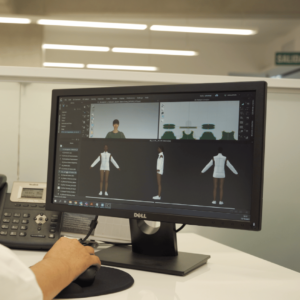3D SAMPLING TECHNOLOGY
REVOLUTIONIZING FASHION DESIGN WITH 3D SAMPLING TECHNOLOGY
In the ever-evolving world of fashion, staying ahead of the curve means embracing cutting-edge technology. One such innovation that’s making waves in the industry is 3D Sampling Technology. This transformative approach utilizes specialized software programs to create digital renderings of clothing designs, allowing designers to craft virtual design prototypes that are not only dynamic and realistic but also eco-friendly. In this blog, we’ll explore how 3D Sampling Technology is reshaping the fashion industry and its key benefits, including the reduction of carbon footprints, waste, time, and even plastic usage, which makes its impact even more significant considering the global movement to decrease plastic consumption.
The Traditional Sampling Process: A Hidden Environmental Toll
Before we dive into the wonders of 3D Sampling Technology, it’s essential to understand the environmental challenges ingrained in traditional fashion sampling methods. Historically, fashion designers relied on creating multiple physical samples to perfect their designs. This process resulted in a considerable carbon footprint due to transportation, as well as excessive waste generation and time in manufacturing these physical prototypes.
Moreover, the traditional sampling process was time-consuming, often leading to delays in bringing new designs to market. The need to ship physical samples worldwide added to the industry’s carbon footprint and increased the usage of bags for shipping.
3D Sampling Technology: A Sustainable Solution
3D Sampling Technology presents a sustainable alternative to these challenges:
-
Digital Prototyping: Designers now use specialized software to create intricate 3D digital prototypes of their fashion creations. These virtual models replicate the final product in detail, including textures, colors, and patterns, with astonishing realism.
-
Dynamic Design Iterations: Designers can make real-time adjustments to these digital prototypes, tweaking elements such as fit, length, and style. This dynamic process eliminates the need for countless physical samples, significantly reducing material waste.
-
Enhanced Collaboration: 3D Sampling Technology streamlines collaboration across global teams. Designers can instantly share 3D prototypes digitally, eliminating the need for shipping physical samples and thus reducing the carbon footprint and usage of bags.
Key Benefits of 3D Sampling Technology
Now, let’s explore the remarkable benefits this technology offers:
-
Reduce Carbon Footprint of Transport: By reducing the use of excessive physical samples and shipments, this technology reduces the carbon footprint of logistics transportation by up to 97%*.
-
Minimized Textile Waste: Less reliance on physical samples means less material waste and significantly reduces textile pollution by up to 95%*.
-
Time Efficiency: The digital design process is faster, with an 80%* reduction in time, enabling quicker decision-making, shorter time-to-market, and more responsive design iterations.
-
Reduce Plastic Bags: Sharing digital prototypes instead of physical samples reduces the need for plastic bags when transporting samples globally, with an 93%* reduction in usage.
*These statistical data are internally calculated by our sustainability department.
In conclusion, 3D Sampling Technology is transforming the fashion industry, aligning creativity with sustainability. It’s helping fashion brands reduce their carbon footprints, minimize waste, save time, and even reduce the usage of bags. As this technology continues to evolve, it will undoubtedly play a pivotal role in fashion’s journey toward a more sustainable and environmentally conscious future.
Explore More Articles Here:
3D Sampling Technology
In the ever-evolving world of fashion, staying ahead of the...
Read MoreNatural Cotton Color
In the ever-evolving world of sustainable fashion, a remarkable transformation...
Read MoreOrganic Cotton Yarns
In a world where sustainability is the buzzword, the textile...
Read MoreFibers from renewable raw wood
In the ever-evolving world of fashion and sustainability, the textile...
Read More


